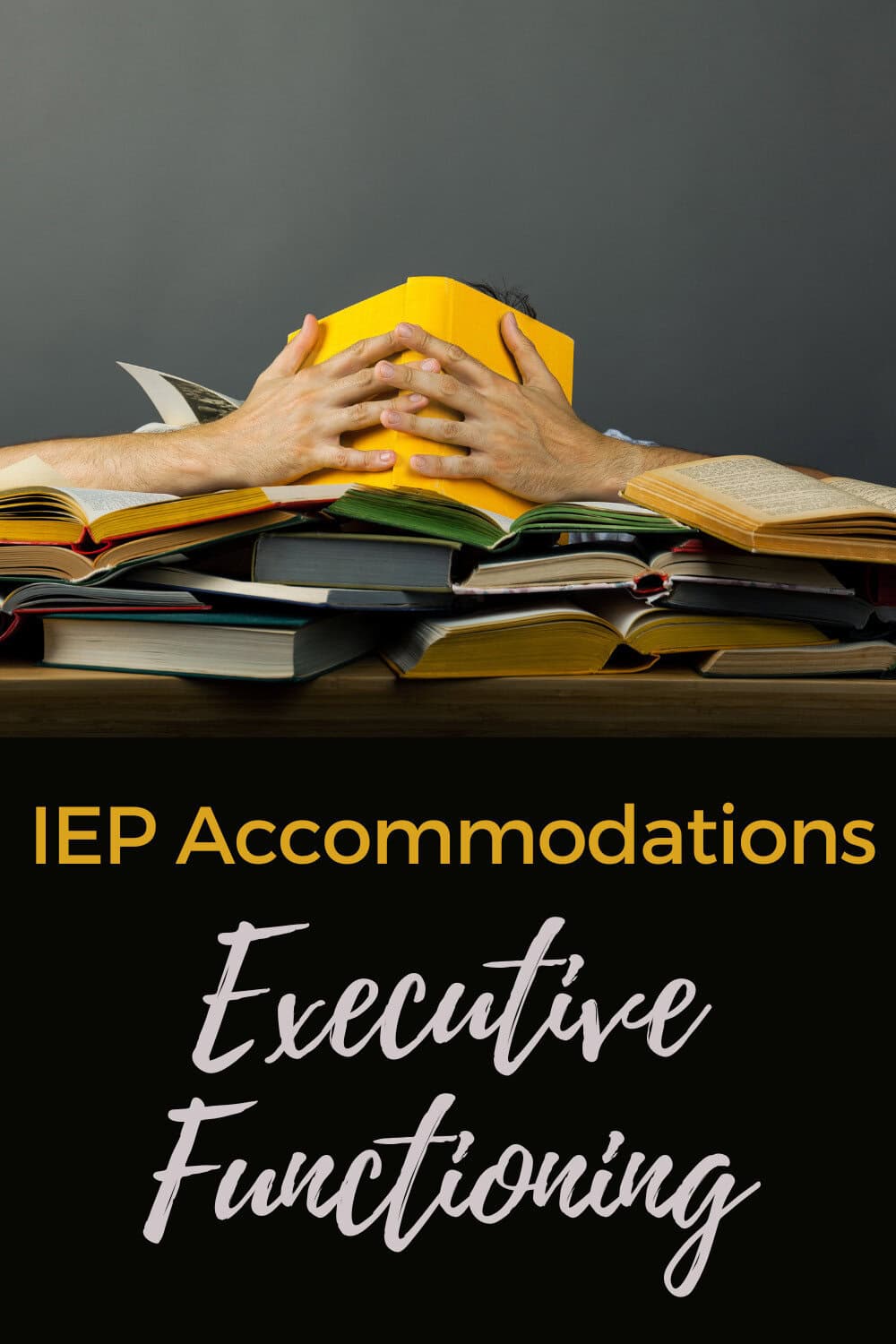Executive Functioning Accommodations for an IEP or 504 Plan (PDF List)
While we have come a long way in recognizing and supporting skill deficits in kids, when it comes to learning disabilities, I find that when it comes to executive functioning, issues are too often thought of as “won’t” instead of “can’t.”

Executive functioning skills rule our daily lives. And when a child or adult lacks such skills, they are often perceived as lazy, unmotivated, scatterbrained, defiant, and worse.
Sometimes a person can improve their executive functioning skills. Others develop supports and measures they put in place to help.
Executive Functioning Accommodations
One example of my personal executive functioning accommodations would be that I use Google Calendar for my workday. I have notifications and alerts turned on so that I don’t miss meetings and calls. Otherwise, I get immersed in a task or project and forget things.
It’s really embarrassing to miss a Zoom call with a client, only to tell them that I was actually sitting at my desk the whole time.
What are Executive Functioning accommodations?
Depending on the advice you read, there are anywhere from 5 to 12 sets of executive functioning skills. When a person lacks executive functioning skills, they are often referred to as having ‘executive function disorder.’
However, this is not an official diagnosis, nor is it in the DSM. It is a term for a person who lacks the skills; that’s it. A child’s success with any of the below skills or tasks will vary based on age.

It’s also important to note that many of these skills and skill deficits overlap. If you tell your child “go to your room and get your backpack, it’s time for school” there are many reasons they may not do this.
It might be working memory, it might be multi-step directions or task initiation…or processing and focus.
I have separate posts for:
- Accommodations for Inference Skills plus some picture teaching cards for inference
- Working Memory Accommodations
- Work Completion Accommodations
- Study Skills Accommodations
- Note Taking Accommodations
- Accommodations for Focus and Attention
- Accommodations for Impulse Control
- Homework Accommodations for an IEP
- Task Initiation or Task Avoidance Accommodations
- Replacement Behaviors for Task Avoidance
Executive Functioning Accommodations
Now that you’ve determined that your child needs support in this area, or perhaps they’ve had an executive dysfunction test, here are some accommodations to consider.
- Visual schedules or graphic organizers for a step-by-step approach-i.e. use of a whiteboard with color markers
- Tools like iPads, smartwatches, visual timers, and laptops.
- Use and prepare visual schedules, and review them several times a day.
- Notification method (public or secret) to alert to changes and transitions
- Ask for large print, written directions with oral instructions whenever possible.
- When shifts in schedules and activities, plan for transitions.
- Create ADHD “to-do” lists/checklists with estimated times.
- Break long assignments into chunks and assign time frames for completing each chunk.
- Simple instructions, step by step, with visuals.
- Create story maps and other similar visuals for reading assignments.
- color code (paper color or ink color) as warranted
- Devices such as a hand-held for reminders on projects, assignments, and meetings such as iTouch, Blackberry, iPhone, etc.
- Large, easy-to-read, erasable color-coded calendar for projects, long-term assignments, meetings, events, activities, chores, etc.
- student agenda with time each day to review and self-evaluate
- Use a “date stamp” for materials received on dates and also due on dates
- Keep an organized workspace; allow class time at end of each segment for this to occur.
- Hang a whiteboard/magnetic to create a visual for a student with a simple list for weekly assignments/projects-use magnets to hang papers due
- Minimize clutter, including visual clutter in the classroom
- Ask for extra textbooks for home use-keep in work areas.
- Have separate work areas with complete sets of supplies for different activities/subjects.
- Schedule a weekly time to clean and organize the workspace.
- Tests can be overwhelming and stressful; options include retaking tests and extended time on tests
- Modify assignments and projects
- Chunk down assignments and projects into manageable-sized tasks
- use highlighters to emphasize important parts
- visual organizers to create timelines
- A “homework system” that the student finds most helpful-i.e. assignment book and checked at home and then at school by staff in the morning with all homework
- Use of computers or technology as much as possible for visual and ease of completing work
- Teachers provide as much information with visuals on the whiteboard and with copies of notes for students
- Reading accommodations-ebooks, kindle, iPad, and use of any visual and auditory form of books for comprehension
- Vocabulary-iPad,iTouch, iPhone, or other handhelds for apps that have vocabulary practice.
In addition to the accommodations listed above, there are many apps for executive functioning that may support your child.
You can also print some of the content from these articles.
Printable List of Executive Function Accommodations
Here you go, by popular demand. I have taken the IEP goals and accommodations from this post and created a pdf for you.
Executive Functioning Printable
I found this online from Jericho Public Schools and thought I’d share it here. Great resource!

